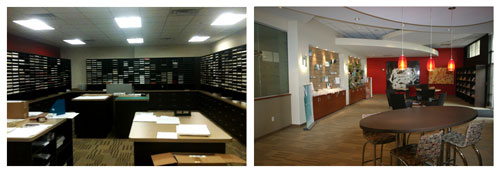
“Unfortunately, due to the economy, we can no longer support Specification Sales Representatives.” The letter from the paper merchant was friendly enough, but …
Sadly, spec reps have been disappearing from the paper landscape. The few that remain usually have multiple roles, with sales taking over the majority of their time.
“There are practically no “traditional” spec reps left in the field,” confirmed a merchant friend of mine who shall stay unnamed. “Most of the spec people nowadays wear 10 different hats.”
The good news is that we all still have access to the paper merchant. They might not be able to call on every designer and small printer, but we can call on them. And more importantly, we can count on them.
The Merchant Role
The designer specs the paper. The printer buys it. The merchant delivers the paper, and the mill makes it. Trying to explain the role of the paper merchant in the paper specifying and buying process can get confusing.
“I like to use the analogy of a supermarket,” says Mendy Eskew, business development, environmental and program specialist at Mac Papers Atlanta. “You would not go to a tomato grower to buy a pound of tomatoes, or to a dairy farmer to buy your milk. The place you go to find the most choices is your local supermarket. In our case, it’s the paper store. We carry everything. We stock it locally. We bring you the expertise, the variety of the choices and what your tradeoffs are.”
Every paper merchant used to have spec reps that called on designers and printers, but the case of our merchant letter is no single incident.
“I actually don’t call on designers as much as I used to at all,” admits Eskew. “The return on investment hasn’t really merited this, so we moved to trying to communicate with them in other ways.”
Following the lead of Clampitt Paper in Texas, one of these ways is a beautiful design center Mac Paper has built in Atlanta. It keeps the center stocked with the latest mill promotions, swatchbooks and printed samples. Designers (and printers for that matter) can go here and use it like their own private sample library.
What your merchant can do for you
Even if you don’t have access to a design center, merchants are still here to help you with a variety of needs.
1. Swatchbooks
“Can you send me a swatch cabinet?” This is still a question Eskew gets on a frequent basis. But, at an average cost of $15 per swatchbook (and we’re talking production cost only), said swatch cabinet adds up to a hefty price tag. Which brings up the question: Are some of these papers even relevant for your work?
So Eskew will dig deeper. “What are you looking for? What are you working on that makes you feel the need for a swatch cabinet?”
“Well, I’ve got a letterhead project that I’m working on.”
“Great. Let’s talk about letterheads. I don’t need to send you …”
Your local paper merchant can’t see you on a frequent basis, but this doesn’t mean you have to work from outdated swatchbooks. (And believe me, I’ve seen some antiques at friends’ studios!) Just take a look at the back of the book. “If they’re over three years old, there’s probably something more current,” suggests Eskew.
2. Mill Promotions
Similar rules apply for mill promotions. Your local paper merchant has the latest and greatest from many mills. Just call them if you hear about a new promotion.
(Of course, if you are a PaperSpecs Pro member, you have access to these anyway. ;-))
3. Sample Sheets and Dummies
“There are hundreds and hundreds and hundreds of drawers of 12.5 x 19 sample sheets in our design center,” elaborates Eskew. “We’re fulfilling orders all day long, helping customers – mainly printers these days – so they can sell the paper to their customers.”
While some printers make their own dummies and mock ups, many turn to their local paper merchant. And so can you.
4. Second Opinions
“If you ever hear that a paper is not available, that a paper is out of your price range, or an issue that you want a second opinion on, you need to call us. We can vet that information for you,” reminds Eskew.
Going out of their way
Beyond the expected services above, many merchants go out of their way to help ensure that your paper choice is right for your project.
“I recently worked with a customer who had a series of mail catalogs coming out,” shares Eskew, “and he was trying to decide which paper to use.”
There were three different weights that the client was considering. Eskew and her team at Mac Papers made up dummies of the self-cover catalog on each sheet in question and mailed them to associates in Seattle, Atlanta and Chicago. The recipients then took pictures of how well the catalogs fared through the mail.
“It’s a surprising exercise, but it’s one of those things we do,” says Eskew. “It wasn’t just about how much more the 65 lb. Cover than the 70 lb. Text is. Saving $2,000 on an $85,000 job isn’t that big of a difference if it doesn’t look good when it gets there.”
Sharing their know-how
“The printer’s expertise is printing and, of course, our expertise is paper,” reminds Eskew.
She and her merchant colleagues all over the country aim to help educate printers and schools about paper.
“The most recent paper school I taught was at Graphcom, the Consolidated Graphics plant here in Atlanta,” says Eskew. “They have a training program for print majors that graduate and want to get into the business. Part of their training is a paper class, Paper 101, and then a trip to a mill. We help facilitate that.”
Oh, and they sell paper too
On top of all this, paper merchants, of course, sell paper. Mac Papers in Atlanta calls a 180,000-square-foot warehouse its own. It has 16 bay doors for trucks and thousands of items stocked on the floor.
Collecting orders all day, Mac Papers’ trucks get packed overnight and go out first thing in the morning. All deliveries are fulfilled before noon.
“And if there’s an emergency, we’ll have an afternoon truck,” assures Eskew.
On the greener side
Several of the larger paper merchants also have a full-time sustainability officer, or dedicated associate, who goes out and educates the print community. This “green” person is also their FSC and other third-party certification liaison to make sure they are always on top of the latest sustainability trends.
Your call for help
There are some things that will not be as they once were, as much as we would like them to.
The fact is, there are less spec and sales reps in the field, and the number of small studios and SOHOs (small office/home office) keeps rising.
By the nature of economics, the remaining reps will call on larger clients first. But, they more than welcome your call for samples, your request for a second opinion, or for you to stop by and browse, if they have the facilities.
“Hey, we’re here to help you!” exclaims Eskew. “We’re here to do anything we can for you, but please be loyal and make sure this order comes through us when the time comes.”
——————–
Seeing designers worldwide struggle to stay current with new papers and paper trends inspired Sabine Lenz to create PaperSpecs, an independent and comprehensive Web-based paper selection tool and weekly e-newsletter. Growing up in Germany, she started her design career in Frankfurt, before moving on to Australia and the United States. Lenz worked on design projects ranging from corporate identities to major road shows and product launches. From start-ups to Fortune 500 companies, her list of clients included Oracle, Sun Microsystems, Deutsche Bank, IBM and KPMG. Lenz is a noted speaker and author on paper issues and educational topics related to the paper industry.
Copyright 2012 PaperSpecs.com












